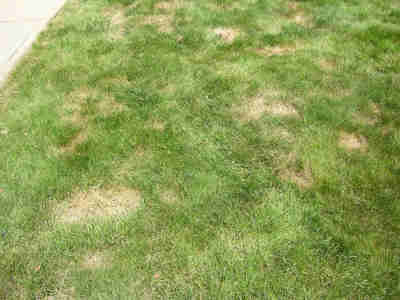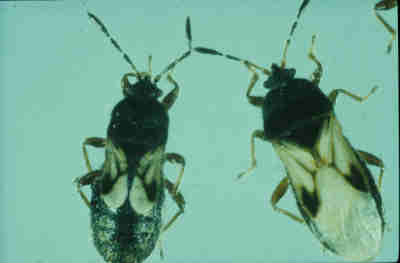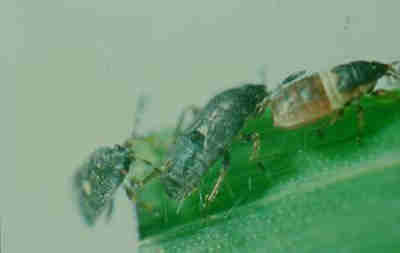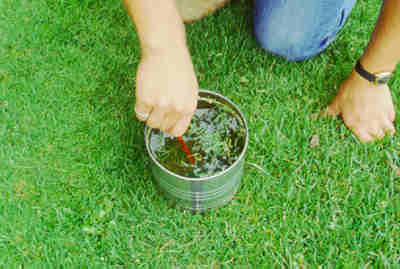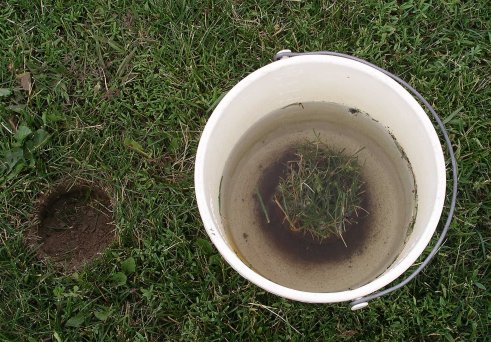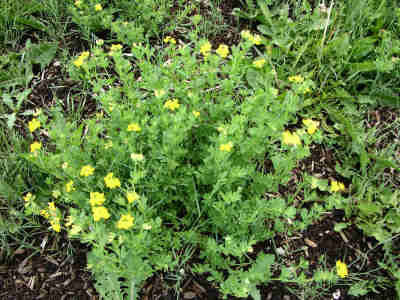Hairy chinch bugs in lawns
Learn about the life history, description, detection and control options for hairy chinch bugs in lawns.
Introduction
Chinch bug is a destructive lawn pest in Ontario. First reported in 1971, chinch bug damage has since become a common home lawn problem in many provinces. Many lawns are only partially damaged, but in severe cases, the entire lawn can be damaged to such an extent that it must be entirely renovated.
Damage
Chinch bugs have piercing mouth parts. They suck the sap from the crown and stems of turfgrass plants. Populations of chinch bugs tend to be aggregated. As a result, the damage usually begins as localized dead patches. These dead areas are brown, irregular, sunken patches, which can coalesce into larger dead areas (Figure 1). Chinch bugs thrive in hot, dry weather. Sunny areas are usually the most affected. All common turfgrass species in Ontario are susceptible to chinch bug feeding, but some varieties may be more susceptible to chinch bug injury. However, research has shown that turf cultivars containing high levels of endophytic fungi may show some resistance to chinch bug feeding.
Figure 1. Chinch bug damage on a lawn.
Figure 2. Adult hairy chinch bugs.
Description
The chinch bug causing damage to lawns in Ontario is the hairy chinch bug, Blissus leucopterus hirtus. This insect is quite small - the adults are 4 mm in length (Figure 2). The immature nymphs are bright red in colour when they first hatch, and begin to darken from brick red to grey/brown when they are nearly mature. The immature nymphs have a characteristic white band across their abdomen, which is eventually covered by the enlarging wings as the insects become larger and mature (Figure 3).
Figure 3. Chinch bug nymph with white band across the abdomen (far right).
Life History
The adult chinch bug spends the winter congregated under trees and shrubs and on the edges of lawns under hedges and in flower beds. As the temperatures become warmer in the spring (mid- to late May), the adults move into the lawn and begin depositing eggs.
The first young nymphs can be found in late May to early June; these individuals become adults by mid-July in the Guelph area. Damage is usually apparent by the middle to end of July. In most of Ontario, severe damage is not noticed until August, after several weeks of hot, dry weather.
Detection
Use one of the following methods to confirm a suspected chinch bug infestation:
Method I (Figure 4)
- Make a cylinder by cutting out the bottom and the top of a large can (approx. 20 cm in diameter).
- Force the cylinder into the turf.
- Fill the cylinder with water. Any chinch bugs present will soon float to the surface of the water.
Figure 4. Method I for detecting chinch bugs.
Method II (Figure 5)
-
Fill a bucket with water.
-
Place a 4 cm x 4 cm square of lawn or a golf course cup changer plug (10 cm diameter) into the bucket.
-
Wait several minutes for the chinch bugs to float to the top.
On a lawn that has little or no damage, take ten of these samples throughout the entire lawn. On lawns where damage is visible, take samples in the healthy grass near the dead patches. If the lawn has more than 20 chinch bugs per cylinder or if roughly 10 chinch bugs are found with the bucket method, damage is likely to occur.
Figure 5. Method II for detecting chinch bugs.
Timing
The best time to check for chinch bug infestations is the second week of July in the Guelph area or when the bird's foot trefoil is in full bloom (Figure 6). (This will vary from year to year and from one locality to another.) At this time, most eggs have hatched, and the initial stages of damage are minimal.
Figure 6. Bird's foot trefoil in full bloom.
Cultural Control
Irrigated lawns are more able to tolerate chinch bug feeding without damage occurring.
Research has shown that turf cultivars containing high levels of endophytic fungi may show some resistance to chinch bug feeding.
Resources
This Factsheet was written by Pam Charbonneau, Turfgrass Specialist, Economic Development Division, OMAFRA, Guelph, and M.K. Sears, Department of Environmental Biology, University of Guelph.
